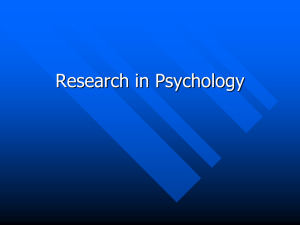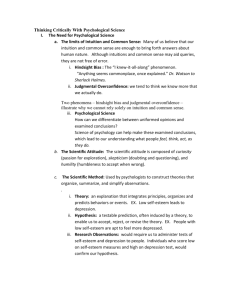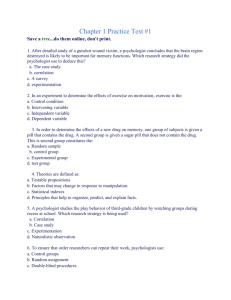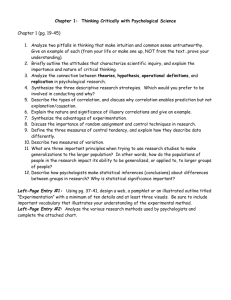ch 1 powerpoint notes
advertisement
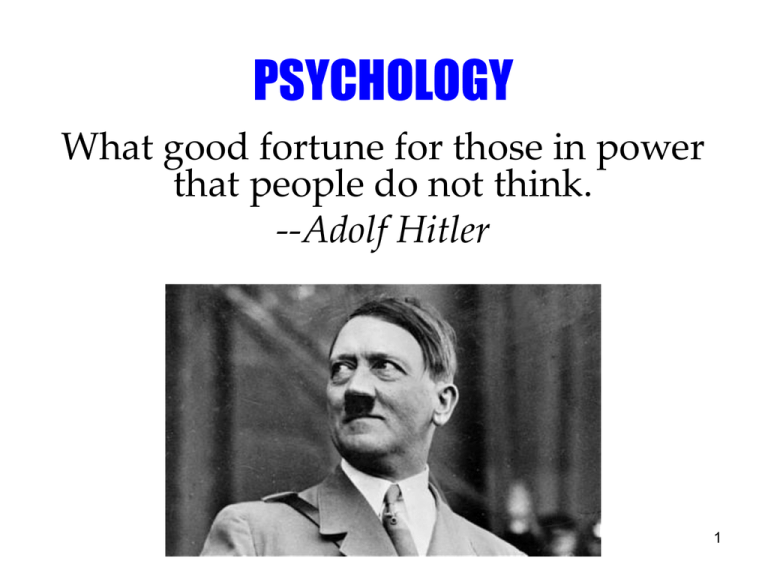
PSYCHOLOGY What good fortune for those in power that people do not think. --Adolf Hitler 1 Peoples’ Impression of Psychology With the hope of satisfying their curiosity, many people listen to talk-radio counselors and psychics to learn about others and themselves. http://www.photovault.com http://www.nbc.com Dr. Crane (radio-shrink) Psychic (Ball gazing) 2 Ch. 1: Thinking Critically with Psychological Science The Need for Psychological Science 3 Intuition & Common Sense Many people believe that intuition and common sense are enough to answer questions regarding human nature. Intuition and common sense may help find answers to questions, but they aren’t error-free. “Out of sight, out of mind.” vs “Absence makes the heart grow fonder.” Which is it?? 4 There are limits on “Intuition” Taxi/ Getty Images Personal interviewers may rely too much on their “gut feelings” when meeting with job applicants. 5 Errors of Common Sense Try this ! If you were to fold a piece of paper (0.1 mm thick) 100 times, how thick do you think it would be? 800,000,000,000,000 times the distance between the sun and the earth (93 million miles). Did you guess much smaller? 6 Hindsight Bias The “I-knew-it-all-along” phenomenon. After learning the outcome of an event, many people believe they could have predicted that very outcome. We only knew Jeffrey Dahmer was a serial killer after he was discovered to be a serial killer. 7 Overconfidence Sometimes we think we know more than we actually know. How long do you think it would take to unscramble these anagrams? Anagram WREAT ETYRN GRABE 8 Anagram WATER ENTRY BARGE 9 10 The Scientific Attitude The Amazing (James) Randi, Magician & skeptic: offers $1 million to anyone who can prove psychic ability Must be curious, skeptical & humble (able to admit you’re wrong). You might have to eat your own words! Critical thinking: thinking that doesn’t blindly accept arguments & conclusions; rather, it examines assumptions, discerns hidden values, evaluates evidence & assesses conclusions. 11 The Scientific Method Psychologists, like all scientists, use the scientific method to construct theories that organize, summarize and simplify observations. • Theory: an explanation that integrates principles and organizes and predicts behavior or events. For example, low self-esteem contributes to depression. • Hypothesis: testable prediction, often prompted by a theory, to enable us to accept, reject or revise the theory. Example: People with low self-esteem are apt to feel more depressed. 12 Research for depression would require us to administer tests of self-esteem and depression. Individuals who score low on a self-esteem test and high on a depression test would confirm our hypothesis. 13 Research Requirements • Operational definition: a statement of procedures (operations) used to define research variables. • Must be able to replicate the results • Replication: repeating the essence of a research study, usually with different participants in different situations, to see whether the basic finding extends to other participants and circumstances. 14 The starting point: Description Case Study A technique in which one person is studied in depth to reveal underlying behavioral principles. Susan Kuklin/ Photo Researchers 15 Clinical Study A clinical study is a form of case study in which the therapist investigates the problems associated with a client. 16 Survey A technique for ascertaining the self-reported attitudes, opinions or behaviors of people usually done by questioning a representative, random sample of people. 17 Wording Effects in a survey Wording can change the results. • Should cigarette ads and pornography be allowed on television? (“not allowed” vs. “forbidden”) • “aid to the needy” vs. “welfare” • “revenue enhancers” vs. “taxes” 18 • False consensus effect: A tendency to overestimate the extent to which others share our beliefs and behaviors. • Population: all the cases in a group from which samples may be drawn for a study • Random sample: a sample that fairly represents a population because each member has an equal chance of inclusion (unbiased) 19 Naturalistic Observation Observing and recording the behavior of animals in the wild and recording self-seating patterns in a multiracial school lunch room constitute naturalistic observation. 20 Correlation A measure of the extent to which two factors vary together & how well one predicts the other. When one trait or behavior accompanies another, we say the two correlate. Indicates strength of relationship (0.00 to 1.00) Correlation coefficient Correlation Coefficient is a statistical measure of the relationship between two variables. r = + 0.37 Indicates direction of relationship (positive or negative) 21 Scatterplots Perfect positive correlation (+1.00) A scatterplot is a graph comprised of points that are generated by values of two variables. The slope of the points depicts the direction, while the amount of scatter depicts the strength of the relationship. 22 Perfect negative correlation (-1.00) No relationship (0.00) The Scatterplot on the left shows a negative correlation, while the one on the right shows no relationship between the two variables. 23 Data Data showing height and temperament in people. 24 The Scatterplot below shows the relationship between height and temperament in people. There is a moderate positive correlation of +0.63. 25 Correlation and Causation or 26 Illusory Correlation The perception of a relationship where no relationship actually exists. Parents conceive children after adoption. Conceive Do not conceive Adopt Confirming evidence Disconfirming evidence Do not adopt Disconfirming evidence Confirming evidence 27 Order in Random Events Given random data, we look for order and meaningful patterns. Your chances of being dealt either of these hands is precisely the same: 1 in 2,598,960. 28 Given large numbers of random outcomes, a few are likely to express order. Angelo and Maria Gallina won two California lottery games on the same day. 29 Experimentation Exploring Cause and Effect Like other sciences, experimentation is the backbone of psychology research. Experiments isolate causes and their effects. Many factors influence our behavior. Experiments (1) manipulate factors that interest us, while other factors are kept under (2) control. Effects generated by manipulated factors isolate cause and effect relationships. 30 An Independent Variable is a factor manipulated by the experimenter. The effect of the independent variable is the focus of the study. For example, when examining the effects of breast feeding upon intelligence, breast feeding is the independent variable. A Dependent Variable is a factor that may change in response to an independent variable. In psych, it’s usually a behavior or a mental process. For example, in our study on the effect of breast feeding upon intelligence, intelligence is the dependent variable. 31 Evaluating Therapies Double-blind procedure: In evaluating drug therapies, patients and experimenter’s assistants should remain unaware of which patients had the real treatment and which patients had the placebo treatment. Random assignment: Assigning participants to experimental (Breast-fed) and control (formulafed) conditions by random assignment minimizes pre-existing differences between the two groups. 32 Experimentation A summary of steps during experimentation. 33 Comparison: different research methods 34 Statistical Reasoning Statistical procedures analyze and interpret data allowing us to see what the unaided eye misses. Composition of ethnicity in urban locales 35 Describing Data A meaningful description of data is important in research. Misrepresentation may lead to incorrect conclusions. 36 Measures of Central Tendency • Mode: The most frequently occurring score in a distribution. • Mean: The arithmetic average of scores in a distribution obtained by adding the scores and then dividing by the number of scores that were added together. • Median: The middle score in a rankordered distribution. 37 A Skewed Distribution 38 Measures of Variation • Range: The difference between the highest and lowest scores in a distribution. • Standard Deviation: A computed measure of how much scores vary around the mean. 39 Standard Deviation 40 Making Inferences A statistical statement of how frequently an obtained result occurred by experimental manipulation or by chance. 1. 2. 3. When is an Observed Difference Reliable? Representative samples are better than biased samples. Less variable observations are more reliable than more variable ones. More cases are better than fewer cases. When is a Difference Significant? When sample averages are reliable and the difference between them is relatively large, we say the difference has statistical significance. For psychologists this difference is set at 5%. 41
